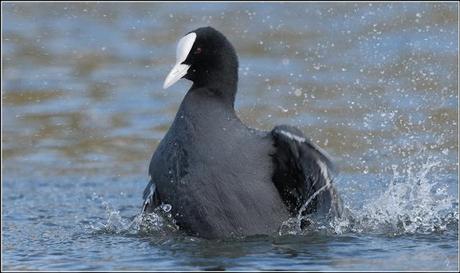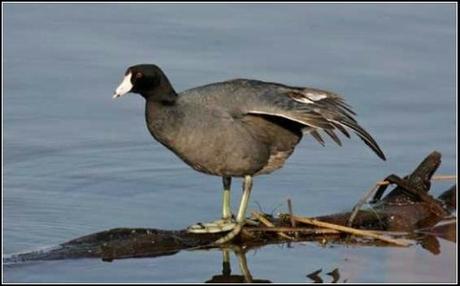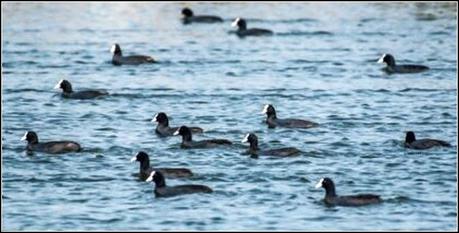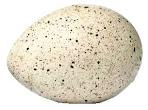Over the last couple of years of visiting the park, I've noticed a significant increase in the number of coots, delightful water birds with their black plumage, that distinctive white 'shield' on their foreheads (giving rise to the saying "as bald as a coot") and their white bills. Sometimes there are as many as sixty or seventy of them out on the lake, where they seem to co-exist peacefully with each other and with other water fowl except at the height of the breeding season when they can get a tad territorial, beating the water with their feathers.

coot feathering
I don't recall precisely when my love for our feathered friends began but it was probably when I was about nine years old. Several things conspired. At that time (early 1960s), Chivers jellies were sold in cardboard packets with pictures of birds on the back, something like twelve in the series, collect all twelve and then send off for a large print of your favorite one. I hated jelly (still do) but my Mum used to buy it for my Dad, so I pestered her to buy specific packets, and when eventually I'd got all twelve, I sent them off for a hand-tinted print of a chaffinch.I'd also recently been bought my first camera, a Kodak Brownie 127. Before I'd acquired the full set of Chivers birds, I used to position the cut-outs in the privet hedge in our garden and photograph them with that Brownie camera. Weird, I know, fake bird pictures!
And then there was Arthur Ransome's 'Coot Club ', which I read at about the same time, and which made it feel cool to look out for the welfare of birds. 'Coot Club ' is a story about a group pf children living on the Norfolk Broads who have formed a vigilante gang to protect the nesting sites of coots from the townies who descend at week-ends and in the Easter holidays and who race about the waterways in motorboats with scant regard for the nesting coots or who think it acceptable to collect birds' eggs. Its pro-conservation message wrapped in an exciting adventure story was relatively ground-breaking for the time.

feet like anchovies
The coot then, readily identifiable from its white blaze, is the largest member of the Rallidae family (which also comprises moorhens, crakes and water rails), and is much bigger when seen out of the water than one might suppose, more the size of a chicken. The French indeed call it informally la poule d'eau (water chicken), though its formal name is the foulque, derived from the Larin name fulica. There are ten species of coot worldwide and the commonest is our fellow, fulica atra , the Eurasiian coot. There are also various North American and South American varieties, one of which even sports a yellow shield. There was an eleventh, the Mascarene coot from Mauritius, but this followed its fellow islander the Dodo into extinction towards the end of the 17th century.Although they are mostly black, certainly as far as plumage is concerned, they do have red eyes and strong yellow legs which end in pale blue feet with long lobed toes, resembling anchovies. They are powerful swimmers and can also run well across water and on dry land, but their short, rounded wings mean they are not the best fliers, certainly not on a par with ducks or geese.
They are omnivorous feeders, cropping on surface algae or diving for weeds, fish and water insects, but they also graze on land for seeds, fruit and small live prey. They build large, bulky nests with a neat bowl. These can be anchored to vegetation in shallow waters (logs, reeds or similar) or they can be free-floating. The female will lay between six and ten eggs at the rate of one per day over a week or so and both male and female coots take turns to incubate the eggs which hatch about three weeks after being laid. The fuzzy chicks with their smoky plumage and red heads more resemble moorhens than coots, enough so to confuse W. B. Yeats who wrote about "feathered balls of soot" in 'Meditations in Tine of Civil War'. Vigilance is required, as the terrapins in Stanley Park lake are quite partial to coot and moorhen eggs, and predatory birds and pike will happily carry off a stray cootlet.
There was a time in this country when adult coots were hunted for food. I quote: "young moorhen are very good eating but I would infinitely rather have a coot." There were traditional coot shoots at several large British wetlands right up until the 1950s, and somewhere the killing goes on, for it turns out there is a trade in dead coot feathers, supplying fly-fishing anglers who like to make their own flies. I quote again: "The feathers on the front of the coot's wings can be used as hackles on a range of traditional soft-hackled wet flies such as the ever-popular 'Waterhen Bloa '" and they cost £15 from stockists of fishing supplies. No wonder coots are occasionally capable of quarrelsome and aggressive behavior if they feel so threatened!

coot flotilla
I've often thought, when looking at the coots placidly floating on Stanley Park lake, that they are reminiscent of warships riding at anchor or sailing in formation, and I knew I'd like to write a poem exploring such an association one day. That day has come, and so here it is (potentially subject to the usual revisions).Coot FleetGeneral synopsis Admiral Coot: mainly fair,wind westerly, veering northwest for a time,
force two, speed approx. at four to six knotsso small wavelets, crests glassy, no breaking.
Irish Sea for you. Cup of tea for me, maybewith a shot of rum or piece of chocolate cake
to keep spirits up, bins trained eyes strainingto survey our fleet riding easy upon the lake
like warships in battle order, uniformly darkdrab gray all with strange white radar domes
and prows pointing into the flow, like Scapaor Souda Bay, red-eyed alert, most definitely
not Pearl Harbour. Wild coots at Poole youradmirable misquote about our pleasing array
of waiting rails, no hint they'll up and awaythough this brisk glorious mid-day. Strength
in numbers of course, deterrent force againstall-comers, and my turn to be witty. Nobody
fucks with the baldies, I side-mouth, crumbsof cake tumbling to the ground for sparrows
to pounce on. And the wind does swing someforty-five degrees as foretold, whereon nine
and fifty synchronised sooty shapes re-orienttheir white bills, resolute in their potent vigil.

* Stanley Park has been voted the UK's favorite park on three separate occasions, the last time being in 2022. Thanks for reading, S ;-) Email ThisBlogThis!Share to TwitterShare to Facebook
